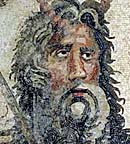 Last night I watched another program on the last-minute excavations at Zeugma. I had seen one earlier but I think this one was different. Of course, I love beautiful mosaics and the mosaics uncovered at Zeugma were some of the most beautiful I have ever seen. In fact, when it showed a computer recreation of the triclinium, I wondered how anyone could concentrate on their meal with such a breathtaking colorful mosaic on the floor.
Last night I watched another program on the last-minute excavations at Zeugma. I had seen one earlier but I think this one was different. Of course, I love beautiful mosaics and the mosaics uncovered at Zeugma were some of the most beautiful I have ever seen. In fact, when it showed a computer recreation of the triclinium, I wondered how anyone could concentrate on their meal with such a breathtaking colorful mosaic on the floor.
"Forty-five kilometers away from Gaziantep close to the town of Nizip on the Euphrates is the tiny village of Belkis, whose inhabitants carefully tender their groves of pistachio trees. The nuts are their sole source of income. Yet not all wealth can be measured in currency, and the villagsed real asset is the magnificent ruins of the ancient city of Zeugma, which has stayed buried beneath the pistachio groves for nearly two thousand years.Belkis/Zeugma is considered among the four most important settlement areas under the reign of the Kingdom of Commanage.
In the Hellenistic Era the city was called “Seleukeia of Euphrates”. The ancient city of Zeugma, originally, was founded by Selevkos Nikador, one of the generals of the Alexander the Great, in 300 B.C. At that time the city was named after the general and called “ Selevkaya Euphrates.” And the population in the city was approximately 80 000. In 64 B.C. Zeugma was conquered and ruled by Roman Empire and with this shift the name of the city was changed into Zeugma to mean “bridge-passage.”
During the roman rule, the city became one of the attractions in the region, due to its commercial potential originating from geostrategic location. Because, the Zeugma city was on the silkroad connecting Antiach to China with a quay on the river Euphrates. In 256 A.D." - Dr. M. Semih SUMMAK (P.hD)
See also: http://www.zeugmaweb.com/zeugma/english/engindex.htm
No comments:
Post a Comment